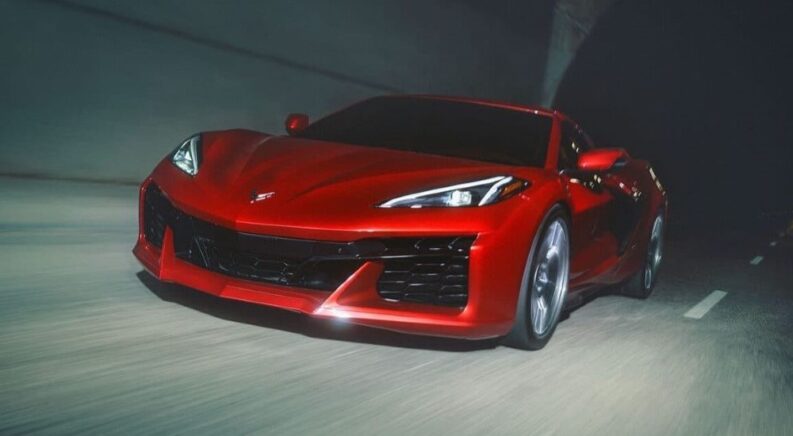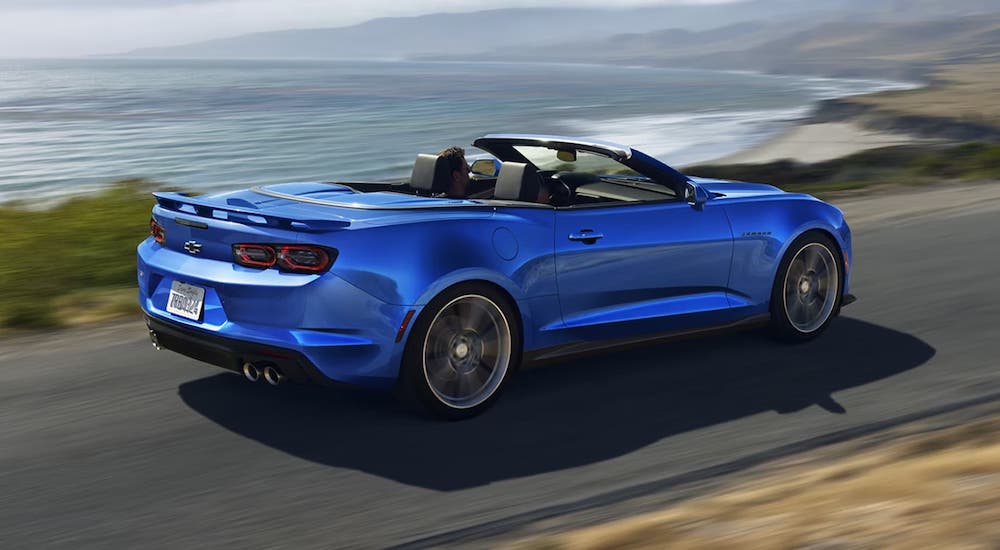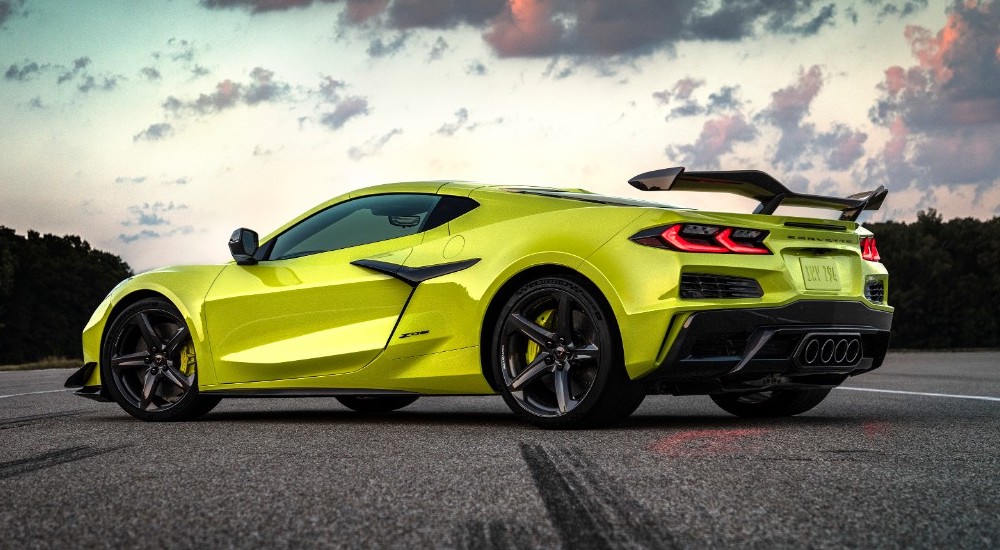For decades, people visiting their local Chevy dealer looking for a performance car have had a choice of two legendary names. However, that choice is about to become one. Production of the sixth-generation Chevy Camaro ended in December 2023, and Chevrolet has no immediate plans for a seventh-gen Camaro or a replacement (though Chevy insists there will eventually be another chapter in the Camaro’s story). For now, this leaves the venerable Chevy Corvette as the sole flag-bearer of the brand’s performance lineup.
It came as a shock to some people when Chevy announced the Camaro was going on hiatus. When you look at the sales data, though, the decision is less surprising. In 2012, the Camaro sold more than 91,000 units––six times as many as the Corvette and more than the rival Ford Mustang. But over the ensuing years, Camaro sales steadily declined, bottoming out at fewer than 22,000 units in 2021. Despite a rebound in recent years, the Camaro now trails the Corvette in sales, with the latter having surged in popularity during the same period. Undoubtedly, the corporate number crunchers took this into account when making their decision.
We thought this would be a good time to look back at these vehicles, how they came to be, and which performance enthusiasts they’ve catered to over the years. While we’re here, we’ll ask the difficult but important question: is a new Camaro even needed, or has it been replaced by the Corvette? Join us in this ode to a pair of cars that have helped define the automotive world.
The History of Chevy’s Biggest Nameplates
Though they both came to be centerpieces of the Chevy lineup, the origins of the Corvette and Camaro were far apart in many ways—and the cars of the past are far different from the cars of today. Let’s take a quick walk down memory lane with these machines.
America’s Sports Car
The C1 Corvette debuted at the 1953 GM Motorama car show and hit showrooms months later. American vehicles at the time were known for being large, powerful, and built like tanks. With the Corvette, Chevy went the opposite way, making a two-seater “country club” roadster with a fiberglass body. Being so far outside the norm, sales were slow the first few years, though they picked up beginning in 1955 when the original I-6 engine was replaced with a V8 power plant.
The second-generation C2 Corvette, produced from 1963 to 1967, is where the Corvette legend really started taking hold. It was completely redesigned as a performance coupe with a series of small-block and big-block V8 engines, an independent rear suspension, and a lighter, lower frame. The third-generation C3 Corvette, with its shark nose design, advanced the legend even further, and five more generations have affirmed the Corvette as a sports car king.
The Mustang Rival
The Camaro also had a quick timeline from concept to production—but it was far more reactionary. Ford unveiled the Mustang in 1964, and while Chevrolet initially didn’t take the vehicle seriously, its rapid rise convinced the Bowtie brand it needed a pony car to compete. The result was the Camaro. First rolled out for the 1967 model year, it was based on the Chevy II Nova and was known right from the beginning for having an array of options, including a whopping 10 engine choices for the first generation.
Like the Corvette, the Camaro underwent a series of redesigns in the coming years. It was also frequently seen in the racing world, including the Trans-Am series and International Race of Champions. The Camaro went on hiatus following 2002 due to poor sales but returned in 2010 with a design that had modern performance but was styled more like the 1969 Camaro, which is among the most respected in automotive circles.
Which Crowd Is Each Car Aimed At?
The modern Chevy Corvette and Chevy Camaro are both typically classified as performance coupes. Still, that doesn’t quite tell the story of each. To help answer the above question, here’s a quick side-by-side of the 2024 model year for each.
Design
For generations, the Chevy Corvette has looked like a futuristic sports car: lean, aerodynamic, and unapologetic. It remains a two-seater to this day but has leaned even further into its supercar spirit with a mid-engine design for its eighth generation. The Camaro has evolved some over the years but still has the vibe of a classic pony car. It also seats four, letting twice as many people enjoy the ride.
Performance
The 2024 Chevy Corvette Stingray has a 6.2L V8 engine with up to 495 hp and 470 lb-ft of torque. With the Chevy Corvette Z06 ultra-high-performance variant, drivers get a unique flat-plane-crank 5.5L V8 that soars to 670 hp and 460 lb-ft of torque. Finally, there is the Chevy Corvette E-Ray hybrid, which adds an electric motor to the powertrain of the Stingray for 655 hp and 595 lb-ft of torque.
The 2024 Chevy Camaro also has three engine options. The 1LT through 3LT trims come with a 3.6L V6 producing 335 hp and 284 lb-ft of torque. Upgrading to the LT1 or SS variants brings a 6.2L V8 with 455 hp and 455 lb-ft of torque. Finally, the Camaro ZL1 is powered by a supercharged 6.2L V8 with 650 hp and 650 lb-ft of torque.
The Corvette comes with an eight-speed dual-clutch transmission. Meanwhile, the Camaro was one of a shrinking number of coupes that still offered a six-speed manual transmission standard, though you could get it with a 10-speed automatic.
Suspension
Both vehicles sport performance-tuned suspensions for aggressive driving. The Camaro has a MacPherson strut multi-link front suspension and a five-link independent rear suspension. Active ride control and an electronic limited-slip rear differential are available on the SS and above. The Corvette steps things up with a double-wishbone front suspension, monotube shocks, and the Z51 package that allows you to lower the car before heading onto the track.
Price
The MSRP for the 2024 Camaro ranges from $30,900 for the 1LT to $72,100 for the ZL1 Convertible. The 2024 Corvette starts at $68,300 for the Stingray 1LT and goes as high as $126,250 for the Z06 3LZ Convertible. While there is a bit of an overlap here, the Corvette is a significantly more expensive car.
The Bottom Line
All in all, the Chevy Corvette is for performance enthusiasts who demand the best of the best. They live fast and are willing to spend on a car that does the same. The Chevy Camaro caters more to people who appreciate great performance but have a smaller budget, are a little old-school, or want a car that’s more practical for day-to-day driving. It also has more trims and other options for people who like a customized car-buying process.
Do We Need a New Camaro?
It seems blasphemous to even ask this question, but we will anyway. After all, if the Camaro sales declined enough to be discontinued while Corvette sales are rising, it’s fair to wonder whether both are essential.
For us, the answer ties into the answer to our last question. The Corvette and the Camaro have specific audiences, and it’s important to offer a car to please both. People who previously would consider the Camaro may not have the money or interest in a Corvette, just like Corvette loyalists probably wouldn’t settle for a Camaro if the Corvette suddenly said goodbye.
The most telling thing to us is that, in recent years, Chevrolet has chosen the Camaro as its representative in the NASCAR Cup and NASCAR Xfinity racing series. The Cup Series uses the Camaro ZL1, while the Xfinity Series Chevy teams run the Camaro SS. For series whose audiences are predominantly male, ages 25-54, and middle class, Chevrolet thought the Camaro was the vehicle most likely to draw interest.
As much as we love the Corvette, there’s still a place in the landscape for cars like the Camaro. Given it’s been retired before only to triumphantly return, we hope to see history repeat itself.






